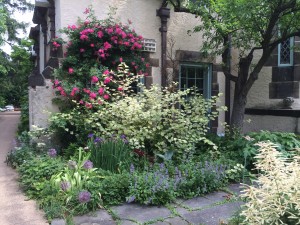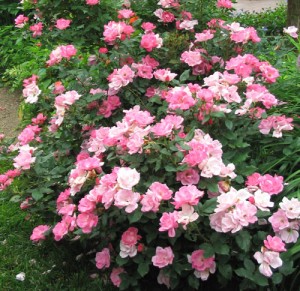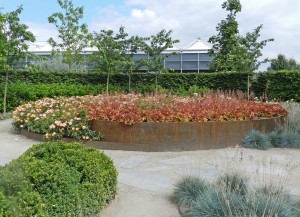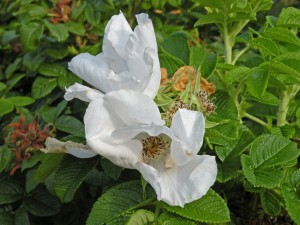
Rosa ‘John Cabot’ is a tough climber that is part of the Canadian Explorer Series. Seen here with Fallopia japonica ‘Variegata’, Allium christophii, Nepeta ‘Dropmore Hybrid’, Iris sibirica ‘Double Standard’ in June
Mention roses to most people in the green industry or to the general public, and the first images that come to mind are bad: disease, bare canes, chemicals, and high maintenance. Many of today’s roses are quite different than the ones we knew as children or as young adults. Those roses were frequently afflicted with black spot and had been so overbred for color and form that they had lost their fragrance, one of the characteristics for which roses used to be known.
Many rose hybridizers, now and over the past ten years, have focused on reviving fragrance and creating disease resistance. That is why I can safely assert that some roses can now be used in sustainable landscapes. Before proceeding, however, we need to define sustainability. In the landscape, sustainable plants are those that are hardy (will not need to be replaced) and that do not damage the environment, or do not need chemicals. They may also be plants that can be used as an alternative to lawn which is extremely water, fertilizer, and energy intensive. Hardiness of all the roses mentioned in this article is to at least zone 5 and some to zone 4.
Many of the David Austin roses are disease resistant and, as a bonus, are extremely fragrant. Some are climbers but many are medium sized tea roses. I’ve planted Rosa ‘Molineux’ at the front of one of my beds and keep it pruned shorter than it would normally grow.
Several of the newer, more sprawling, groundcover type shrub roses, e.g.the Meidiland™ and the Flower Carpet® roses, are wider in diameter than height and can be used to create large masses of color and form on slopes, around buildings, along walkways (most of these are fragrant), and in containers. For the most part, the self-cleaning flowers are double or semi-double and include a color range of mostly pinks, reds, and whites although the past few years have seen the appearance of yellows and ambers.
Another series of roses that have a traditional look, vibrant colors, and prolific rebloom as well as all of the disease resistance that we want are the Easy Elegance® roses, bred by Bailey Nurseries. These own-root roses need very little pruning but can be pruned to reduce size to the desired height. These roses tend to be three to four feet high and four feet in diameter although there are some smaller ones.

Rosa Oso Easy® ‘Peachy Cream’, Lilium ‘Dani Arafin’, Allium giganteum, Lychnis chalcedonica ‘Morgenrot’, Rosa ‘Dr. Van Fleet’, Geranium psilostemon in my front garden

Rosa Oso Easy ‘Cherry Pie’, Spiraea ‘Magic Carpet’, Baptisia foliage, Allium christophii deadheads, Heuchera ‘Georgia Peach’Spiraea ‘Magic Carpet’, Baptisia foliage, Allium christophii deadheads, Heuchera ‘Georgia Peach’ – all provide shades of pink in one of my front beds
Not well known yet are a group of smaller roses, the Oso Easy™ series from proven Winners. I first grew Peachy Cream and Paprika (reddish orange with a yellow eye) and was delighted with how well they could be integrated into my mixed beds. The first year, they were only a foot high and wide but by the second year, they had increased in size to two feet but still worked well as front of the border plants. The aptly named Fragrant Spreader has petals that are bright pink on the outer edge and white near the center. It is the first Oso Easy™ rose that is wider (five feet) than tall (one to two feet) and should be used as a groundcover. Cherry Pie, a cherry red with a hint of ruby, and Strawberry Crush, a medium pink with a yellow center, are the two newest varieties.

Rosa ‘Pink Knockout (Photo credit: blog.behnkes.com)
The series that has probably gotten the most publicity is the Knock Outs. Introduced by Conard-Pyle, they are tough: disease resistant, relatively drought resistant, and long blooming. More colors continue to be introduced. I would recommend thinking of Sunny Knock Out® as a white rather than a yellow because it fades rather quickly but it is the only fragrant cultivar. Most are in the two to three foot range. The size will vary with the amount of water and whether and how much they are pruned in the spring.
While ultimately fairly drought resistant, they will all require regular watering the first year and will bloom better in succeeding years if deeply watered once a week. All of these roses have glossy green foliage that is one of the factors in their resistance to both black spot and mildew. That resistance means that chemicals are no longer necessary to combat these evils that have decimated rose foliage in the past.
In the face of all the publicity that the new roses have garnered, we tend to overlook the Rugosa group that was introduced into cultivation in Europe around 1770 but grown in the Orient for centuries before then. Long known for its salt tolerance, the heavily wrinkled foliage is quite disease resistant. They do not bloom as prolifically as the roses mentioned above but most Rugosa develop hips that add another element of interest to the late summer and fall garden.
In our quest to stop using chemicals that damage the environment, it is incumbent upon us to search for plants that are capable of surviving assaults by diseases, fungi, and pests. In our quest to diminish the amount of energy we expend on growing turf, we need to find alternatives that are less demanding. I’m not advocating the total eradication of turf but I do think that we don’t need as much. Who would have guessed that roses would help to fill this niche?






0 Comments